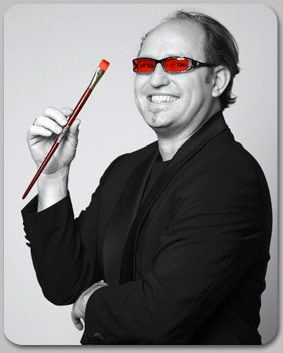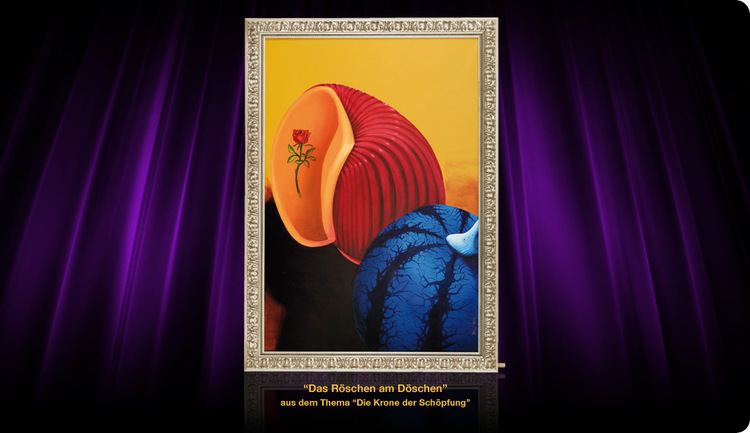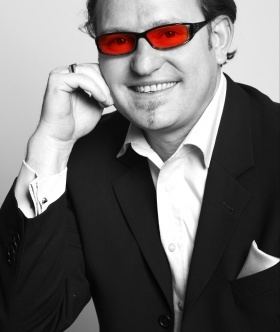Nationality German | Name Ralf Metzenmacher | |
 | ||
Movement Retro-Art, Pop art, Still life | ||
Ralf metzenmacher m nnlichkeit heute der video kommentar zum katalog
Ralf Metzenmacher (born July 26, 1964) is a German painter and designer. He is a representative and pioneer of Retro-Art, a synthesis between art and product design. Metzenmacher sees his Retro-Art technique as a revitalization of 17th century still life painting and as a further development of Pop art.
Contents
- Ralf metzenmacher m nnlichkeit heute der video kommentar zum katalog
- Briefpapier f r ralf metzenmacher puma pinselartist
- Biography
- Concepts
- Further development of Pop art
- Revitalisation of still life painting technique
- Target group and collections
- Picture cycles
- Painting technique and materials
- Solo exhibitions
- Group exhibitions
- References

Briefpapier f r ralf metzenmacher puma pinselartist
Biography

Metzenmacher was born in Aachen. He attended Aachen University of Applied Sciences (FH Aachen) from 1986 to 1991. There he studied object- and product design under Prof. Christiane Maether and Prof. Ulf Hegewald, specializing in painting technique and drawing. Between 1991 and 2004 he worked as a designer for Puma. As director, towards the end of his time there he was responsible for the Footwear Europe and Accessories International division. He played a significant role in the process of transforming the sports manufacturers into an international Sports-Lifestyle brand.

From the early 80s onwards, Metzenmacher spent more and more of his time concentrating on painting technique. He produced a multitude of paintings (genre scenes and still lifes) during his degree and alongside his job as designer. These are all documented in his book “The other world” (self-published). He has worked as a freelance artist since 2004 and lives and works in Bamberg.
Concepts

The artist Ralf Metzenmacher uses his painting technique to polarize and surprise through the regeneration of numerous concepts. He describes himself as a “paintbrush artist” and refers to his exhibition rooms as “schooruum”, an onomatopoeic reference to the English word “showroom”. He propagates the term “Retro-Art” to describe his own painting technique. As self-proclaimed “pioneer” in this area, his aim is to successfully integrate this synthesis of art and design into the Fine art world and to establish its position in the art market.

“Further development” of Pop art
Retro-art painting technique is reminiscent of Pop art, with intensive strong colours and a reduction and simplification in its presentation. However, whilst Pop art links art with graphics, Retro-Art combines art with product design. “Classic” Pop art generally uses two-dimensional images from comics or advertisements to depict (American) symbols as icons of folk culture. In contrast, Retro-Art uses three-dimensional representations and adopts a critical standpoint on current issues and trends in youth culture and lifestyle.
“Revitalisation” of still life painting technique
Some of Metzenmacher’s pictures (e.g. “The Crown”) feature surreal elements, reminiscent of Salvador Dalí’s work. However, Metzenmacher does not see himself as a surrealist, more as a modern ambassador for the classical still life painting technique. The works and painting techniques of Spanish artist Francisco Zurbarán have had a lasting influence on him, as have the still life paintings of Italian artist Giorgio Morandi.
Retro-Art painting technique is effectively a “revitalisation” of 17th century still life painting technique. As a result, Metzenmacher predominately paints modern still life paintings. Depending on the particular theme, he selects simple objects in daily use (e.g. cigars, punching bags, cars) and portrays them in an unusual way. He also uses familiar symbols from the history of art (e.g. mussels, snails), often modifying or distorting them.
Individual objects are portrayed with a disciplined graphical precision. They are separated from their usual surroundings either to stand alone, or to be presented in an artistically engineered context surrounded by ethereal space. The luminescent contrasting colours distort the materiality of the objects and confound the viewer. Frames in the style of those from times gone by form an essential part of each picture.Target group and collections
His painting technique appeals primarily to a young and young at heart public whose interests lie in fashion, design and lifestyle products. As a result, Metzenmacher with his history in product design has added “collections” to go with each original. These collections are printed art pieces which differ in colour, size and fittings (frames). This idea of different collections came from the fashion industry and has been transferred to the world of art by Metzenmacher. He calls his collections “edition” and “rallipan”.
Picture cycles
Metzenmacher prefers to paint picture cycles. For example, in the cycle “The Crowning of Creation” he portrays primary and secondary female characteristics in a thought provoking manner using snails, mussels and melons. Titles for his work include such idiosyncratic examples as “The Cherry Rose” and the “The Melon Princess”. In the cycle “The Lord of the Crown” he uses sports cars and a smoldering cigar with a penis ring as a symbol of masculinity.
Picture cycles from Ralf Metzenmacher
